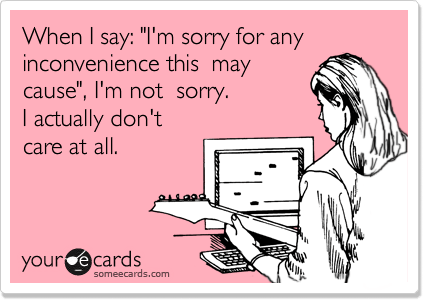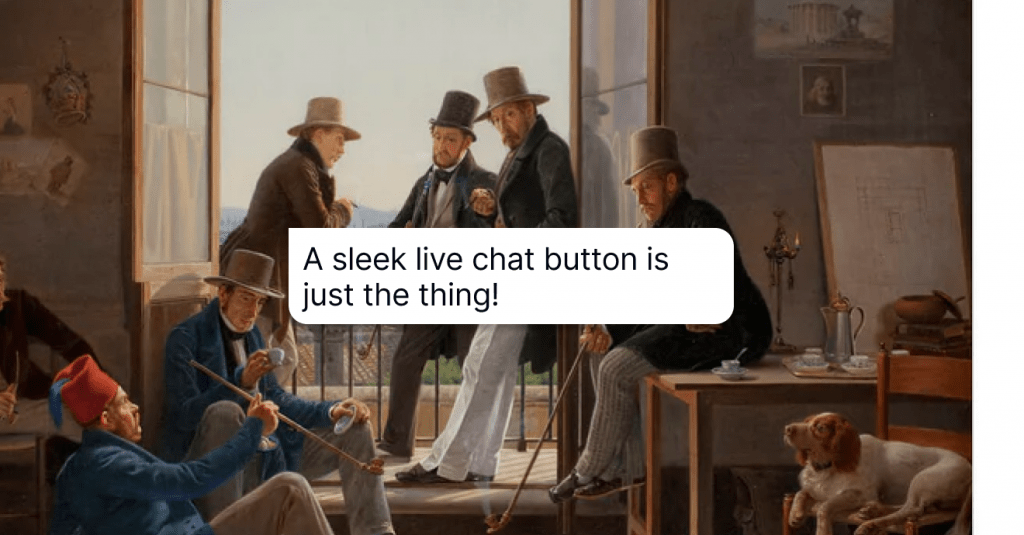Apology Made Easy: 10 Best “Sorry for the Inconvenience” Templates
Learn all the original equivalents to the phrase "sorry for the inconvenience" and use them in your next customer service interaction!
Written by Olesia Melnichenko

No man is always wise. And there is no getting around it. Mistakes happen; every product has inherent flaws, no matter the industry in which you’re engaged. If the system goes down, a client’s package is lost, or the food is delivered late. Such stories are widespread in a customer service niche.
How do you say it’s your fault? Obviously, blurting out a trivial “Sorry!” isn’t an option. Being a business owner, you probably care for customer loyalty and retention and want your audience to stay with you as long as possible.
We are here to ease your distress when composing those heartfelt lines. After reading this piece, you’ll say “sorry for the inconvenience,” sounding more natural, original, and not clichéd. Here it goes!
What does “sorry for the inconvenience” mean?
Brand-client communication usually starts with a welcome message for customers when you greet users and promise fruitful cooperation for years ahead. But what if users experience major drawbacks and the company is to blame? Saying ‘sorry for the inconvenience’ seems like the only option…
When you say these words, you apologize for the mistake and the problems caused by your actions (or the lack of any) to a client. This is often an overused phrase in the customer service industry, and many people interpret it as “We know we messed up, though you have to put up with that”. That’s why you have to quit using this line left and right. That’s our next stop.
Reasons to stop saying “sorry for the inconvenience”
- Lack of authenticity. The phrase in question has been used since year one and already become cheesy. Most clients know about it and think a customer support team may use it on autopilot, even in an email broadcast. Don’t do that, change the system!
- More than a minor inconvenience. People face a poor customer experience, could it be worse? A brand shouldn’t be sugar-coating even if the situation seems like a trifle (from a brand’s perspective). At the end of the day, you want customer perception to be positive.
- Unempathetic meaning. Let’s call a spade a spade: “Sorry for the inconvenience” may sound a bit callous. In most cases, this is true without a follow-up letter. Do you want your already unhappy customers to feel treated with no respect?
- No urgency. One of the first rules of service is solving customer complaints ASAP. If you just say you’re [terribly] sorry, it won’t show your willingness to lend a helping hand quickly.
Understanding customer perception of inconveniences
But first, let’s understand what inconvenience is from the customer’s point of view. Because as you’ll see later, it’s not just about saying sorry; it’s about understanding how your customers feel and what’s at stake.

Negative impact of poor customer service experiences
When people encounter inconveniences, it can have a cascading effect on their perception of your brand. For instance, they can experience:
- Dissatisfaction: Whether it’s a shipping delay or a glitchy app, dissatisfaction is a strong emotion and can quickly spread through word-of-mouth or online reviews.
- Lost trust: Trust is hard-won and easily lost. If people don’t believe you can deliver a hassle-free customer support experience, they might look elsewhere.
- Diminished loyalty: Even the most loyal clients may explore other options when inconveniences become the norm.
How to improve customer perception
We will talk about it in more detail later, but for now, let’s outline some things to help you turn this ship around and improve your customers’ perception of inconveniences:
- Swift resolution: Address issues promptly. The faster you resolve a problem, the less negative impact it will have. Train your customer service team to be proactive problem solvers.
- Transparency: Be transparent about what went wrong and why. Unsatisfactory customer appreciates honesty. If you messed up, admit it. It’s the first step in building trust.
- Prevent recurrence: After addressing an issue, prevent it from happening again. Whether it’s a technical glitch or a logistics hiccup, learn from mistakes and put measures in place to avoid repeats.
Customer loyalty and perception of apologies
Lastly, remember that customer loyalty is closely tied to their perception of your apologies. When you apologize sincerely and act to make things right, you can strengthen satisfaction. They see that you care about their experience and that matters.
But how to do it right, you may ask? Well, let’s get into the practical stuff – those effective apology templates that will help you express your regrets and make amends effectively without repeating clichés.
“Sorry for the inconvenience” alternatives to enrich your repertoire
Brands do apologize. However, they do not always say, “We apologize for any inconvenience“. The meaning is kept, though the words are different. Before we cut to the chase here, let me set real-world examples.
Adidas was sorry after sending an email with an insensitive subject line to all Boston Marathon finishers. Clearly, “Congrats, you survived the Boston Marathon!” was not a pleasant thing to say on a Patriots’ Day race. The message was met with pushback. So, what were their apologies for the inconvenience? “We are incredibly sorry” and “We deeply apologize for our mistake“.
Another example is Jeff Bezos saying, “Sorry for the inconvenience” after the infamous Kindle accident. Amazon deleted “1984” and “Animal Farm” copies from the users’ Kindles. Two things caught my eye: 1) the CEO didn’t express regrets point-blank, and 2) the end line “With deep apology to our customers” seems whole-hearted and unconventional.

Being a language enthusiast, I’m constantly on the lookout for unusual vocabulary and lexical expressions as it is. So, I want to provide you with alternative ways of saying “sorry for the inconvenience” without actually pronouncing these words (substituting them with both formal and less formal synonyms, if you will):
- Please accept my sincere apologies…
- How can I make up for the [late reply/this unsatisfying situation, etc.]…
- I realize the situation is discomforting, I would feel it too…
- As a business, we can see how frustrating this issue can be…
- This is unacceptable, and we realize we let you down.
- We apologize for the problem…
- I regret any trouble you may have faced with the system…
- On behalf of our team, I would like to make amends for [the issue]…
- It’s our bad, and we do understand that! Let us find another solution…
- Your [issue] is already taken care of. Mea culpa!
- I want to extend my sincerest apologies for…
- We deeply regret this incident…
- This is quite a situation. As a token of our heartfelt apology, we are…
- We screwed up! The weather and our horoscopes are to blame!
- As a way to ask for your forgiveness, we’re offering…
- This was an annoying slip-up on our part, and we are sorry.
- We shouldn’t have done that. The fault is 100% ours.
- We’re extremely grieved that … And to make it up to you we..
- I offer you an apology for the discomfort you may have faced …
- Huge apologies to you as our loyal and much-valued customer.
Sometimes, when things go south, you can offer a customer your sincere apology. But you have to do that right. The most important thing is to be creative, stay professional, and not lose your nerve (or at least try to do that).
Quick note!
The bad and the good ways to say “sorry for the inconvenience,” which you will want to write on 👇🏻
| Do NOT say that! | DO say that! |
|---|---|
| Sorry, can’t help it… | Huge apologies for this fine misunderstanding… |
| To be honest, I have no clue how to handle this, so sorry. | I understand you completely! Let me provide several alternatives… |
| It’s not my department, why don’t you go ask another one? | If I were you, I would be frustrated too! Let me loop my colleague from another team in. He/she will help! |
| What part of “sorry” in “I am sorry” didn’t you understand? | Let me highlight again that it’s our bad, but we’re on to it to solve the issue faster. |
| Pity, and we are sorry for the inconvenience! | I am on the same page with you here. Could you please provide some details… |
| Sorry for the inconvenience! Is it working now? | Thank you so much for your patience! The issue is completely taken care of. |
| We regret any inconvenience this may cause you… | Thanks for bringing this up to us. Mea culpa! Give us some time to get onto this.. |
10 customer service situations to say “Sorry for the inconvenience”
In the heart of the moment, it’s easy to give up on all the courtesy and professional training. With that in mind, we’ve devised possible customer service scenarios and included all the alternative ways to say you are sorry.
You can use these templates in live chat, email, or even phone interactions and mix them up with the synonym expressions I provided above. Besides, if things go south, you can insert these in a thank you for order newsletter. Ace your next “We apologize for the inconvenience” talk, and always think of the right words:
-
Poor customer service
Dear [customer name],
On behalf of [company name], I want to extend my sincerest apologies for your negative experience with our customer service agent.
I realize that [agent’s name] was [unhelpful/rude/unprofessional/etc.] in solving the issue. Your frustration at not being properly directed to a supervisor is completely understandable.
At [company name], we pride ourselves on going the extra mile daily to ensure that our customers’ needs are being fully met. I know that we have let you down. We are really sorry for that.
We do our best to train our representatives on properly handling our customers’ issues.
Thank you for bringing this issue to our attention. We always look for ways to improve our service, and your feedback is highly valued.
Should you need help, please do not hesitate to contact me directly.
Sincerely,[Agent’s name]
-
Delayed delivery
Dear [customer name],
I regret any trouble you may have experienced with our delivery service and the package you ordered this [day of week].
As you are our loyal customer, we want you to be the first to know that there is a new supply this week. You will receive a message from us when the items are available to order.
Please advise us whether you want to cancel your order or have us ship a new package once it becomes available.
Again, we are sorry for the inconvenience.
Best wishes,
[Agent’s name]
-
Billing issues
Dear [customer name],
I hope you are doing well. We apologize for the problem concerning our billing system and the amount charged previously. Our best agent is already handling your issue and will get back to you with the solution.
To improve your experience, we [extend the trial period/ offer a discount, etc.]. Kindly consider the information in the attachment.
Feel free to reach out to me in case you need any help.
Best regards,
[Agent’s name]
-
Refund request
Dear [customer’s name],
Please accept my sincere apologies for the inconvenience you have experienced with us recently. It’s shocking, given that we devote extra attention to every client and transaction.
Our team has taken steps to narrow down the causes of this mistake and found out that [tell the cause of the error without getting into specifics]. This is our fault, and we take full responsibility.
To fix the situation, we will provide you with a refund ASAP.
Thank you for your insightful feedback, We are improving our customer service to eliminate such mistakes down the road.
Sincerely,
[Agent’s name]
-
System downtime
Dear [customer name],
You might have noticed our [app/system/service] had a minor turbulence today. Mea culpa! All the technical issues are already taken care of, and it won’t happen again.
It’s the first time a downtime occurred since we launched, and we deeply regret this incident. Please feel free to look through our full explanation published on our [blog].
Don’t hesitate to contact our team once you come up with further questions.
Have a nice one!
[Agent’s name]
-
Mass sorry for the inconvenience message (after a downtime)
Dear [customer name],
I’m here to update you on our service downtime on [date and time]. Service was fully restored on [time].
I realize this is disappointing, and take my apology for any inconvenience this has caused you. Please be informed that our team has been working really hard to resolve these incidents. [Clarify incident details].
As a token of apology, we are [issuing you a discount of X% for this month’s subscription/ free trial period/ free feature]. If you feel this isn’t enough, please let me know. We will discuss everything.
Have a great day,
[Agent’s name]
-
Bug problem
Dear [customer name],
Unfortunately, a game-breaking bug has slipped through our devs’ hands recently. Please accept my sincerest apologies for the problem with [insert your option] you have been dealing with our product.
Our devs team has confirmed [specify the issue], and they are working hard on resolving it.
We have prioritized this, and this bug will be completely fixed in another X business days.
Customer experience is our top-of-mind priority, so we will make sure we do thorough testing to avoid such issues in the future.
We do understand the severity of the issue and the impact it might have on your business, and would like to suggest a workaround until it is fixed. You can try [workaround]. I hope this helps.
Feel free to [schedule a screen share session/ hop on a quick call to set everything up/ chat with us].
Best regards,
[Agent’s name]
-
Late reply
Dear [customer name],
Oops! Sorry for the delayed reply. Mea culpa!
The thing is that [explain why you are late]. I think we can deal with the problem this way [provide the solution].
Ask me questions if need be!
Best wishes,
[Agent’s name]
-
Scheduled maintenance
Dear [customer name],
Our team is scheduling maintenance on our [servers/platform] for [date, time, and duration of the maintenance]. Sorry for the inconvenience caused to you in this regard.
This maintenance is highly essential because [explain the importance of the maintenance and benefits to customers]. So glad that you understand!
Thank you for being our customer.
Sincerely,
[Agent’s name]
-
Clarifying a problem
Hello [customer name],
Thank you for contacting us concerning [the issue]. Our team is already on it. We appreciate your patience.
We put efforts to understand the problem. Though it persists. The actions taken were [enlist the actions].
To streamline the process, we will need certain information from you. [Ask questions].
Thank you for staying with us. No doubt, we’ll find the solution.
Best wishes,
[Agent’s name]
How to write templates yourself?
While pre-made templates can be handy, creating your own can add a personal touch and authenticity to your apologies. Besides, we understand that these templates do not cover all possible situations. Here are some tips to help you get started:
- Be human and empathetic: When we start composing an apology email, our language often takes on a formal tone, laden with complex sentences and jargon. But the most critical element of any apology is sincerity. Begin by acknowledging the mistake or issue and express your genuine regret. Use straightforward language, and avoid being defensive.
- Explain the situation and take responsibility: Your customers appreciate knowing why the inconvenience occurred. And take ownership of the problem, even if it wasn’t entirely your fault. Common phrases like “We understand that we made a mistake” or “I want to apologize for any inconvenience” demonstrate accountability personally.
- Outline the solution and offer compensation (if applicable): Clearly state what you’re doing to resolve the issue or how you plan to prevent it from happening again. Consider offering compensation or a goodwill gesture if the situation calls for it. This could be a discount, a freebie, or an expedited service.
- Keep it concise: While it’s essential to be thorough, keep your apology concise. Avoid overly long and convoluted explanations.
- Edit and proofread: Finally, it’s always a must to take a moment to review and edit your genuine apology for clarity, grammar, and tone. A well-crafted message reflects professionalism.
For instance, Mugsy had a little email mishap, resulting in what they humorously called a “jumbled mess of images”. But instead of just shrugging it off, the team promptly sent out the correct email along with a brief, heartfelt apology. They owned up to their mistake, fixed it, and extended a genuine sorry.

Strategies for improving customer service interaction
As a support pro or a business owner, this is where the rubber meets the road. Let’s talk about the role of the agents and how to understand the needs of those frustrated folks on the other end.
The part of the customer service representative
Let’s acknowledge the frontline heroes – your customer service reps. They’re your company’s face (or voice), and their role in apologies is pivotal. Therefore, they should focus on a few things:
- Empathy: Understanding and acknowledging a customer’s frustration or inconvenience goes a long way in diffusing tense situations.
- Problem-solving: Make sure your reps are well-trained in your products or services to provide a quick and simple solution, not just apologies.
- Effective communication: Jargon and technical terms might confuse your customers more. Encourage plain, easy-to-understand language.
Just look at this informal and heartfelt apology from Kukuruza. Such a humane approach can easily win the hearts of your customers.

Tips for successful communication with customers
It is logical to learn how to actually talk to your customers. And there are no magic secrets here, just basic rules of courtesy. For example, active listening: your reps should be like sponges, soaking up all the customer feedback. It’s not just about waiting for your turn to speak; it’s about truly understanding the issue.
Also, remind them not to engage with emotions. Sometimes, they’ll encounter customers who are, well, not so calm. Your reps need to keep their cool. A calm demeanor can be contagious and can help de-escalate tense situations.
To avoid at least part of such scenarios, your customer support representatives should respond timely. Nobody likes to wait, especially people who experience frustration with your product. Quick canned responses, even if it’s just to say, “We’re looking into this,” can go a long way in making customers feel valued.
Understanding frustrated customers’ needs
Yes, frustration is the key. Understand this emotion, and remember how uncomfortable it was for you. Next, decode the minds of frustrated customers. Because what? Right, the customer service interaction is where your reputation is on the line.
- Resolution: They want their issue fixed, and they want it fixed yesterday. Your reps should prioritize finding a solution.
- Respect: A frustrated person still wants to feel respected. Treating customers with respect is non-negotiable, even if they’re upset.
- Clear information: They want answers, not more questions. Ensure your reps provide clear, concise information without sending customers on a wild goose chase.
Bottom line
Your “sorry for the inconvenience” messages should be focused on one mission: to win the customer back. To succeed in this endeavor, give it one hundred and ten percent.
As you can see, we didn’t reinvent the wheel in our scenarios, just ordinary words expressed offbeat. Remember the basics: call a customer by name, be friendly, be specific, and be creative in solutions. Plus, don’t scatter your apologies with unsound statements. It’s OK to own mistakes.
To train your speech muscle, decent all-in-one software is highly needed. Sign up for a free 14-day trial with HelpCrunch, the feature-packed support platform, and positively communicate with customers 🙏




